“Rebecca, always Rebecca. Wherever I walked in Manderley, wherever I sat, even in my thoughts and dreams, I met Rebecca. . . . I should never be rid of Rebecca.”
—from Rebecca by Daphne du Maurier
words to inspire before you expire
“Rebecca, always Rebecca. Wherever I walked in Manderley, wherever I sat, even in my thoughts and dreams, I met Rebecca. . . . I should never be rid of Rebecca.”
—from Rebecca by Daphne du Maurier
“There was Manderley, our Manderley, secretive and silent as it has always been, the grey stone shining in the moonlight of my dream, the mullioned windows reflecting the green lawns and the terrace. Time could not wreck the perfect symmetry of those walls, not the site itself, a jewel in the hollow of a hand.”
—from Rebecca by Daphne du Maurier
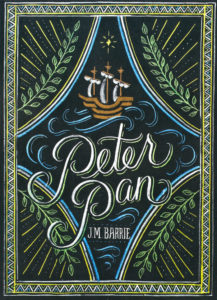 Welcome back, class.
Welcome back, class.
Peter Pan seems accidentally special—like it struck the right cord with its audience and they never let it go. It’s inventive and ageless, but it’s also simple. It’s for children, written by a man that seemed never to grow up (and I mean that only in a good way), so there’s a reason it’s so magical. Reading it as an adult, I picked up on the fact that Peter Pan wasn’t meant for me at all—it only clued me in on the fact that, being a grown-up, my innocence was already gone. The rest of its efforts were directed towards its childhood audience.
Compare Peter Pan to a good Pixar movie, for example—they are family movies, and while they are kid-oriented, they are as much for the parents as they are for the kids. The Incredibles is as much a story about the children with superpowers as it is about the two superhero parents, in a struggling marriage and trying to keep their family together. Inside Out is the story of 5 different characters—emotions—making developmental decisions on behalf of a young girl, and I promise you that’s more for the parents’ benefit than for the kids’.
But that’s not Peter Pan—just like The Outsiders by S. E. Hinton, which was written by a teenager for teenagers, Peter Pan is about children and, in its way, written by a man that might as well have been a child. That’s why it should have made the list of books everyone should read before they die.
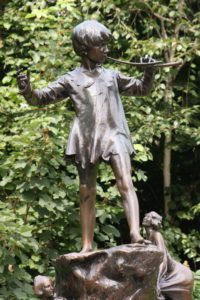
A statue of Peter Pan in Kensington Gardens, which served as inspiration for J. M. Barrie as he wrote the story.
Growing up, I knew the story of Peter Pan from its adaptations—the animated Disney film was familiar, and a few spin-off/prequel books pulled a Wicked and made Captain Hook the focus. But my favorite adaptation is the 2003 movie, staring Jeremy Sumpter as Peter Pan and Jason Isaacs as Captain Hook. By staying more faithful to J. M. Barrie’s original story, it was a darker take—to my surprise, the original novel is darker than it appears.
For one thing, Peter himself is everything a child can be when unsupervised. He is innocent, impulsive, and (to use the novel’s exact word) heartless. There’s something unnatural, even monstrous, about this boy that never grows up—we don’t really get to the point that we’re supposed to fear him, but being his friend is not something you’d want. Maybe that’s the adult in me talking . . . who’s to say?
Then there’s Wendy Darling and her two siblings, John and Michael, who escape with Peter impulsively to fly to Never Never Land, where they might get the chance to remain children forever. They meet Peter’s gang of Lost Boys (a nicer crew than the Lord of the Flies boys, but same principle); they see mermaids, fairies, Indians (yes, this is fairly racist and does not age well); and they fight pirates, specifically the maddeningly evil Captain Hook, who hates Peter with a burning passion. Adventure ensues.
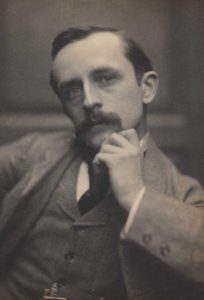
Author J. M. Barrie
I’ve compared Peter Pan to The Wind in the Willows before—both are simple stories, meant specifically for children, as opposed to stories like Alice in Wonderland. Lots of children’s stories are allegory and symbolism, meant to convey deeper meanings for the people that look for them. Alice in Wonderland makes a point to criticize society through methods specifically for adults to understand, unbeknownst to the children enjoying the fantasy. While Peter Pan certainly has its moments of meaning—powerful, moving moments—they aren’t buried in literary codes. The amazing things about Peter Pan are on the surface, not between the lines.
And one of the things that makes Peter Pan so amazing is Never Land itself—it’s Disney World. It’s an imaginary theme park, complete with every fantasy creature and villain a typical child wants. Wonderland and Oz are mighty scary at times, but Never Land is a dream come true. Even the pirates and the danger they pose are fun and exciting. Never Land is imagination, and Peter Pan is fantasy come true—that’s why it should have made the list.
I’m just finishing The Way We Live Now by Anthony Trollope—it may be from the same era and even location as Peter Pan, but they are both about as far apart as The Lord of the Rings and The Lord of the Flies. So I’ll save my discussion for next time. Until then,
Prof. Jeffrey
Hello again, class.
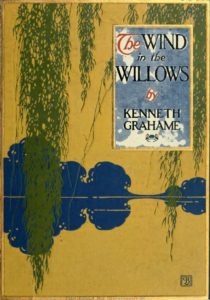 The Wind in the Willows is one of the most pleasant stories I’ve read in a long time. It’s short and entertaining, full of talking animals on crazy adventures, and never shallow enough to lose suspension of disbelief. More importantly, it’s a children’s story—easily what a parent would read to their children every night, which means unlike most novels on the 50-books list, this actually is something everyone should (and could) read.
The Wind in the Willows is one of the most pleasant stories I’ve read in a long time. It’s short and entertaining, full of talking animals on crazy adventures, and never shallow enough to lose suspension of disbelief. More importantly, it’s a children’s story—easily what a parent would read to their children every night, which means unlike most novels on the 50-books list, this actually is something everyone should (and could) read.
The story follows four animal characters, who each live on or around a great river: the Mole, the Water Rat, the Toad, and the Badger. Their stories intersect mildly, as the Mole adventurously abandons his home or the Toad tries desperately to return to his own, and the characters gather together at the end to wrap up the plot. It’s funny and sweet.
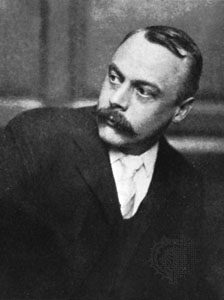
Author Kenneth Grahame
I don’t think the story and characters would be all that special, though, if it wasn’t for Kenneth Grahame’s writing. He adapted the bedtime stories he would tell his son into this novel, and because of that, he made it meaningful. Grahame balanced the animal-instinct for adventure with the desire for the comforts of home; he harnessed the distinctions between creatures and embraced those differences; and he portrayed the simple elements of nature with the same depth and complexity as the world of humanity can be perceived—at least by a child. His care for this story made it beautiful, and that’s why it makes the list.
Everything seems to have a dream-like quality as well, and that’s no mistake—the word “dream” is used obnoxiously often. Apart from a few main story arcs, most of the chapters feel like individual short stories, jumping between random plot points like a dream would. The talking animals, the exciting adventures, the beautifully comforting language . . . The Wind in the Willows is a childhood dream brought to life.
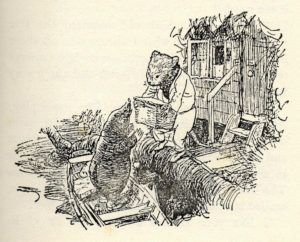 I do still question it’s inclusion on the list. The excellent writing and the portrayal of a child’s fantasy dreamworld is already on the list—Alice’s Adventures in Wonderland. Lewis Carroll’s classic is also much more popular and more fantasy-heavy than The Wind in the Willows, so why include Grahame’s novel at all? If we needed another children’s fantasy, we could have also included The Hobbit or Peter Pan . . . why The Wind in the Willows?
I do still question it’s inclusion on the list. The excellent writing and the portrayal of a child’s fantasy dreamworld is already on the list—Alice’s Adventures in Wonderland. Lewis Carroll’s classic is also much more popular and more fantasy-heavy than The Wind in the Willows, so why include Grahame’s novel at all? If we needed another children’s fantasy, we could have also included The Hobbit or Peter Pan . . . why The Wind in the Willows?
I don’t have much of an answer. It’s not that The Wind in the Willows is bad, but there are plenty of books missing from this list. Any one of them could have replaced this one. In any case, this would only be a concern if we were ranking the books on this list, and since that’s not what the list is about, I encourage you all to give this story a go.
I’m reading Harper Lee’s To Kill a Mockingbird next—for my book #25! Halfway there! And there’s no better book to wrap up the first half of my blog with.
Until next time!
Prof. Jeffrey
“‘And you, you will come too, young brother; for the days pass, and never return, and the South still waits for you. Take the Adventure, heed the call, now ere the irrevocable moment passes! ‘Tis but a banging of the door behind you, a blithesome step forward, and you are out of the old life and into the new! Then some day, some day long hence, jog home here if you will, when the cup has been drained and the play has been played, and sit down by your quiet river with a store of goodly memories for company.'”
—from The Wind in the Willows by Kenneth Grahame
© 2025 50 Books to Read Before You Die
Theme by Anders Noren — Up ↑
Recent Comments